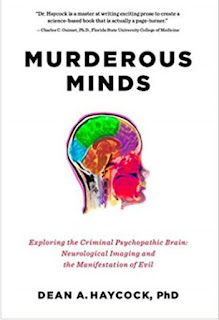Muderous Minds- Dean A Haycock phD- A book review.
Murderous Minds by Dean A Haycock- A book review.
Dean A Haycock is an author who I highly recommend for anyone
studying Criminology, Psychology, anthropology, and Neuroscience. He
specialises in Science and Medicine. This is shown through his PhD research in
Neuroscience from the Brown University in Rhode Island. I thoroughly enjoyed
reading his book ‘murderous minds’. It is important to note that the research displayed
in the book does acknowledge the separation between psychopathy and violence. This book does explore the minds of a subsection
of psychopaths. They have been classified as ‘criminal psychopaths’. This is
the distinction between those who have ‘successful psychopathic tendencies’
such as struggling to comprehend and adapt to social situations, reading body language
and emotional cues, but do not act on these lacking abilities in a
criminalising manner. Encompassing the ‘criminal psychopath’ Dean explains that
there are characteristics which could make an individual who already has ‘successful
psychopathic tendencies to be more prone to committing acts of violence and aggression.
His research further explains that there is more to psychopathy than meets the
eye. Dean categorized in his book, 4 subsections of psychopathy. These were Narcissistic,
borderline, sadistic and the antisocial psychopath.
I think that there is a lot to be said about neuroscience
and its significance in investigating and providing promising research into the
mindset of a ‘criminal psychopath’ This research can be shown through identifying
brain abnormalities in the hippocampus and amygdala. These are examples of
brain components which are responsible for planning, controlling and performing
voluntary movements. The lack of empathy and rational emotional displays have been
shown through brain scans to be a factor to explaining psychopathic tendencies
when these brain components have been damaged. Within the book – ‘murderous minds’
this research has been backed further by Jim Fallon’s conclusion that signs of
damage to the orbital prefrontal cortex have connections to the rise in
psychopathic and violent behaviours within an individual who suffers from these
brain deficiencies.
Throughout the book, I debated to myself the old classic debate
of nature vs nurture. I have come to my own personal conclusion that, yes
environment and lack of substance in an individual’s life can really contribute
to the theme of psychopathy, as well as political and monetary policies which
have a momentous impact on an individual’s lifestyle, acts committed such as robbery
and theft which may result in the taking of someone’s life. However, I argue
that these are lifestyle choices, which an individual may decide to make rationally
under the theme of doing what is necessary to survive in a challenging political
climate. Look at British austerity and
the link to the rise of knife crime to cite an example. Knife carriers I wouldn’t
say are born to be knife carriers. Circumstances have shaped the methods of living
and surviving.
However, on the other lens, neuroscientific research has
shown that in the cases of incarcerated individuals convicted of murder, there
has been in numerous case studies, brain abnormalities particularly in the motor
cortex, which Is the part of the brain which is responsible for emotional functioning.
Evidence displaying cysts for example, means that the individual is evidently
not going to have the same processing features which most of us have with a ‘normal
functioning brain’. These are abnormalities rooted inside us as a component as opposed
to a choice made due to social and environmental circumstance.
The book does also leave a lot of questions unanswered. Citing the ‘homicidal triad’. It explains the
‘effective measurement for homicide in detecting serial killers and psychopaths’
particularly in children. The listed 3
components are bedwetting, Arson and Animal abuse. These are notable parallels,
however as Karen Franklin identifies, these are characteristics of individuals who
have faced extreme trauma and stress. However, these individuals typically do
not grow up to be serial killers or psychopaths. The unanswered question for me,
is that surely research should continue to add to or even subtract the ‘homicidal
triad’ to really define the early characteristics of a serial killer. The
ethical question which also surfaces is that ‘should be have the power to
assume if someone’s going to grow up to be a serial killer’? Should we adopt labels
onto someone before they have even reached the age of puberty?
In the final chapter of the book, Dean A Haycock, explains
that there is simply not enough funding for the research of ‘psychopathy’. As
he rightly says, the benefits for society would be immense with further funding
grants. It would shape prevention programmes, the cost of crime prevention in
the long run would be decreased, and the hope of emotional closure of victims
of psychopaths who would question ‘how someone could be capable acts such as
murder, kidnap and stalking’. Furthermore I agree with his other principle that
research on ‘psychopathy’ needs to adopt a more global outlook. We are living
in a world of differing societies, values and traditions. However, we mostly
share the mutual connection of wanting to ‘keep citizens safe’ and to
understand the minds of ‘criminals’. I feel a more global outlook would really do
far more progress in terms of neurologically identifying and preventing acts of
‘psychopathic behaviour’.
I fully recommend murderous minds, it is a book which can leave
you asking more questions surrounding psychopathy and murderous minds. Dean A
Haycock also answers the big questions.

Comments
Post a Comment